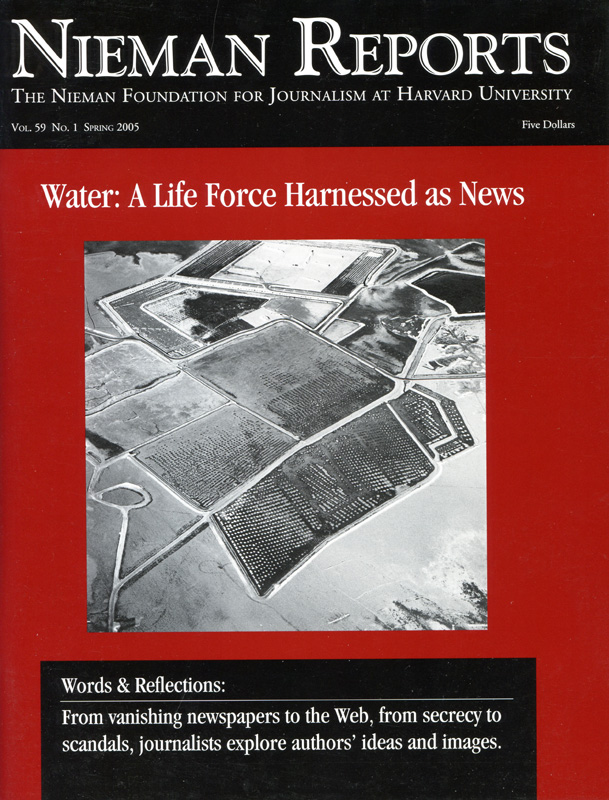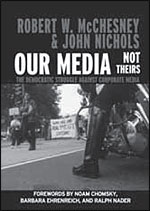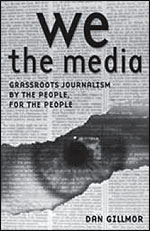We aren’t living in a Golden Age of journalism, as evidenced by the fair number of books being written today telling us just how ungolden a time this is for the press and how it got this way. But if there is any good news to be found in the midst of all of this criticism it is that there are still some who are feisty and fractious enough to say some pretty tough things about the press—things journalists might not like to hear, but should.
An indictment of the press is made very forcefully in “Our Media, Not Theirs,” a slim volume subtitled “The Democratic Struggle Against Corporate Media” by two practicing media critics, Robert W. McChesney and John Nichols. The press, they write, was intended by the Founding Fathers to be a “stern watchdog,” and freedom of the press was the only guardian of the people’s liberty. Things haven’t worked out that way. That watchdog has been transformed into a lapdog, and the nature of its coverage is “uncomfortably close to that found in authoritarian societies with limited formal press freedom,” these authors contend.
McChesney, who is a professor in the Institute of Communications Research at the University of Illinois, and Nichols, who is the Washington correspondent for The Nation and associate editor of the Madison, Wisconsin Capital Times, are impassioned about their subject as they argue forcefully against conventional assumptions of conservative conspiracy or liberal bias. The real issue confronting the press, they argue, is profit.
Modern supernational media companies have the ability now to generate profits that go beyond those garnered by almost any entity in history (other than absolute monarchies) when they integrate journalism into a marketing machine for their other products, such as movies, books, TV networks and shows and licensing revenues. This has resulted in the creation of a “media system” that relies on the government and mainstream journalism as smoothly functioning, reliable components of a system built on three things: media concentration, corporate ownership, and unquestioning reliance on official sources.
This system didn’t happen by accident, and it isn’t working for the greater good. In their book, McChesney and Nichols focus on two main points. The first is that “the current media system is the direct result of explicit government policies and that these policies have been made in a corrupt manner with minimal public participation.” On this point, they write, “there is virtually no debate.” And their second point flows from the first: “… the existing media system in the United States operates in a manner that is highly detrimental to the requirements of a democratic and self-governing society. The system works to advance the interests of the wealthy few, rather than the many.”
The authors issue a clear call to action: “It is imperative for Americans who care about democracy to come together and organize a mass movement for reform of the media system.”
Supporting Evidence
To support their argument, the authors of “Our Media, Not Theirs” cite well-known but still depressing facts about media concentration in the United States, with its media landscape dominated by fewer than a dozen corporations, some of which have annual revenues of up to $35 billion and followed by a second tier of another dozen smaller, less integrated companies. This concentration has been abetted, the authors write, “by a collapsing commitment on the part of the federal government to serious antitrust prosecution, a diminution of the federal standards regarding fairness, and government ‘deregulation,’ most notably the 1996 Telecommunications Act.”
Equally well-known (and perhaps more personally painful to many of us) is the pressure corporate owners have put on newsrooms to cut budgets and join the rush to the bottom in journalistic standards—reshaping coverage away from the controversial and the complex and toward celebrity-driven drivel.
As tough as McChesney and Nichols are on owners and managers, they don’t spare journalists in their criticism. Freedom of the press was not written into the Constitution to protect an objective, profit-hungry journalism, according to McChesney: In the Founding Fathers’ day there was no such thing. Most newspapers were closely linked to political parties, and the First Amendment was intended to protect the diversity of partisan viewpoints that were competing for popular support.
It was only 100 years ago, at the turn of the 20th century, that the increasing effectiveness of advertising turned newspapers into money machines and drove a major consolidation of media. The new profit-centric ownerships were faced with a problem: how to create a new business model for newspapers in the midst of a drastic reduction in the diversity of opinion as cities with a dozen dailies now had only two or three dailies—a situation that threatened to damage the credibility and thus the profitability—of their properties. So they turned to a “professional” journalism of objective reporting and the use of qualified sources as a solution.
The result, after a century of even more radical consolidation, says McChesney, is that journalism has come to rely almost entirely on official sources. What this means is that corporate and governmental spokespersons too often dictate the story. Reporting has become “stenography.” (McChesney has produced a sort of executive summary of their argument that appears as a chapter in another recent book, a second edition of “Into the Buzzsaw,” edited by Kristina Borjesson.)
Other works echo these conclusions. For a decade, Project Censored (founded in 1976 by Carl Jensen and now headquartered at Sonoma State University in California) has issued an annual Censored volume that rounds up stories neglected by the “media system” (“Censored 2005” has recently been published). As a title, the word “censored” creates some confusion. These are not stories you haven’t heard about because they have been repressed, but rather many of them have been “underreported” or “benignly neglected” but neither of these characterizations express the urgency of this “news that didn’t make the news.” The top “censored” story in 2004 was “The Neoconservative Plan for Global Dominance.” In the 2005 volume, it is “Wealth Inequality in 21st Century Threatens Economy and Democracy.”
The common thread that runs through these press criticisms is the media system’s willingness to accept official sources rather than devote time and resources to doing independent reporting. To choose this other route might be expensive, embarrassing to the government, or disagreeable to corporate media owners. But to not do this reporting is to, in effect, remove these sensitive topics from the public agenda and shield the special interests they benefit from the public view.
The work done by Project Censored provides the supporting detail that McChesney and Nichols leave out of their brief book. On the “official sources” point, just as one example, in her introductory essay in “Censored 2004,” Democracy Now!’s Amy Goodman cites a Fairness & Accuracy in Reporting (FAIR) study that found 92 percent of all U.S. news sources interviewed on the nightly network newscasts in 2001 were white, and in those more than 14,600 reports, six-tenths of one percent of the sources were Latino—a hardly accurate reflection of the actual population of our country.
Who Owns the News?
What McChesney and Nichols call the “media system” Dan Gillmor labels as Big Media in his book “We the Media.” Though the authors express similar views about the origins of media concentration and the role of government and corporate interests, Gillmor is less interested in Big Media’s causes than its cures, and he’s extremely upbeat about those: one cure, he writes, has already been found, and it is the Internet. Gillmor recently left his job as a technology columnist for the San Jose Mercury “to embark on a new adventure, a project to help bring online grass-roots journalism to more people and communities,” as he explained in his farewell column.
Gillmor’s book is as expansive as McChesney and Nichols’ book is dense. He has axes to grind, as they do, but he also brings to his writing a good reporter’s sense of when and how best to use a story—and he has years of reporting behind him that he uses to illuminate his topic. He shares interviews he’s done with technology figures and also writes about the impact of Howard Dean’s Web-based presidential campaign. For those who have not been paying close attention to the Internet, “We the Media” provides a valuable tour of its most active edges, both in its technology and its culture. If Weblogs and Wikis, open source and creative commons are not familiar words or phrases, then Gillmor is a chatty and informative guide.
He is also a true believer in the possibility that the Internet can save journalism—and thus democracy. How? By turning Big Media back into its true self, like the potion that reforms Mr. Hyde back into Dr. Jekyll, making reporting once again more responsive to the public’s right to know than the corporation’s right to profit. To be sure, the Internet will, he says, have profound effects on what journalism is—how it is regarded, defined and practiced. His long-time experience as a blogger leads him to forecast an amalgamation of journalists, newsmakers and the audience, in which “journalism” is seen as more of a technically aided conversation, rather than a top-down monologue.
McChesney and Nichols regard the Internet as a glass that is nowhere near half-full. They acknowledge changes that the Internet has made in our lives “… but,” they write, “the Internet has yet to be proven successful as a platform to launch commercially viable competition to the media giants; again and again, the market trumps the democratic potential of the technology. This tends to marginalize dissident Web sites. And the Internet is hardly some autonomous force in society. Legislative, regulatory and judicial determinations regarding copyright, antitrust and access issues will decide exactly how progressive a medium it will become.”
Gillmor doesn’t disagree and, in fact, devotes considerable discussion to intellectual property and copyright issues such as the Digital Millennium Copyright Act as Big Media abuses of the free flow of information in society. He fears intellectual property claims might eventually be used by corporate interests to limit the wide-open information flow on the Internet itself. (This topic was covered in depth in another recent book, “Free Culture, How Big Media Uses Technology and the Law to Lock Down Culture and Control Creativity,” by Stanford law professor Lawrence Lessig.)
What’s the Solution?
Gillmor turns rather pessimistic in the closing chapters of “We the Media.” He enumerates several threats to the Internet, efforts that would use technology to reverse the freedom that was created by technology in the first place. He discusses loss of privacy, filtering to control access to particular Internet sites or content, an unrelenting war being waged by media companies against any kind of peer-to-peer data exchanges (which would be, by definition, beyond intellectual property controls), and a sellout by the technology industry—the makers of computers and networking hardware—to Big Media.
The only bright spot in this gloomy picture is the possibility that digital technology might fundamentally disrupt the economics that shapes the broadcast media. “In the case of radio, television, cable and satellite TV,” write McChesney and Nichols, “governmental agencies grant monopoly rights to frequencies and/or franchises to private firms at no charge. Whoever gets these licenses is essentially guaranteed a profit. The value of this form of corporate welfare over the past 70 years is mind-boggling. It is certainly in the hundreds of billions, if not trillions, of dollars. Nearly all of our huge media giants today are built on the backs of this corporate welfare, though you would never know it by listening to their rhetoric.”
If spectrum space were not scarce, on the other hand—if there were no effective limits on the number of TV channels or radio stations individuals could receive—Big Media would face greatly increased competition, and its advertising revenues (and stock prices) would be greatly reduced. This is what Gillmor sees coming as broadband, high-capacity cable and wireless Internet connections spread—technologies for streaming media that could deliver endless amounts of content—and have the potential to make every Internet user a producer as well. (Just since Gillmor’s book was published the emergence of “podcasting” has added substantiation to his view.)
If scarcity were no longer an issue, Gillmor admits, “we have a lot of work ahead to fix a hopelessly broken regulatory system.” But if the regulatory system can be fixed, he says, “the sky is literally the limit for future communications.” There are dangers: “Open systems are central to any future of a free (as in freedom) flow of information. Yet the forces of central control—governments and big businesses, especially the copyright cartel—are pushing harder and harder to clamp down on our networks.” Still, Gillmor writes, “I’ve no doubt that technology will eventually win, because it is becoming more and more ubiquitous. I also have faith, perhaps misguided, that public officials will ultimately pay proper attention to the interests of their constituents and not just to the industries that pad their campaign war chests.”
Rather surprisingly, McChesney and Nichols sound similarly optimistic: “The question is what will tomorrow’s media system look like,” they write. “And it will be answered as we decide the sort of regulation the government will provide— and in whose interest and according to what values that regulation will be asserted. Media corporations want more of the same: greater concentration of ownership, bigger monopolies, less responsibility to inform or enlighten, and more profits. Most Americans, if they were given the choice, would opt for something different.”
The difference between Gillmor’s message and that of McChesney and Nichols is that the media critics are convinced that technology can’t win by itself and the regulatory system will resist fixing. They contend that it is going to take a massive grassroots movement to reform U.S. media. In a chapter worthy of the Censored series, they survey media-reform movements around the world and share stories that many Americans probably have not heard before, such as the emergence of the “Third Left” movements that are focused on media issues in several countries, Sweden’s ban on advertising to children, and the struggles over the privatization of broadcast media in New Zealand and Australia.
McChesney and Nichols drive home a familiar argument as well: “The fundamental challenge at this point is not convincing people that something should be done about media structures that do more harm than good. The challenge is to convince people that something can be done. That simple leap of faith, if it is taken by enough Americans, will provide us with a base that is strong enough to challenge corporate control and radically reshape the media landscape in the United States.”
This notion alone—that there is a need to laboriously build a case for the mere possibility of change in our media landscape—is by itself the strongest argument for how badly such a movement is needed and ought to point the way to where journalists’ responsibilities reside.
David DeJean, a 1978 Nieman Fellow, has worked at the intersection of journalism and technology for 25 years as the editorial director of a newspaper’s videotext service, a consultant to online services, a computer trade paper and magazine editor, a freelance technical writer, and a Webmaster. He is the editor of Systems Management Pipeline, a Web site for corporate information technology managers.




